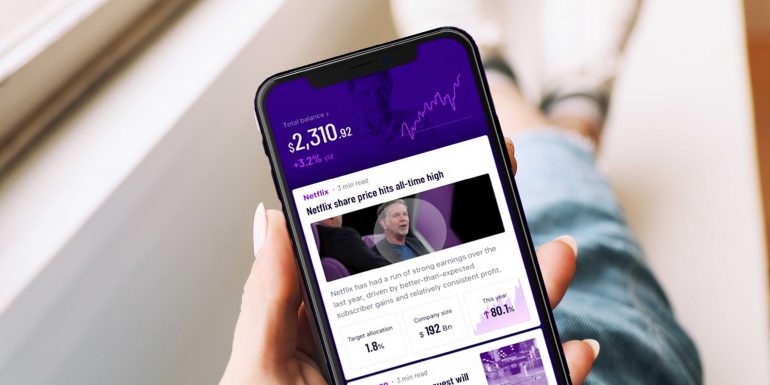Top 4 investment super apps
These days, investors and SMSF trustees aren’t confined to just the realms of the big banks. Today, there are a stack of investment apps that can be downloaded to streamline the entire process from idea generation to implementation. These apps may offer lower fees and the convenience of trading or investing on the go. They can also lower the barrier to entry for new investors who don’t have a large amount to invest or lack the experience; Robinhood in the US is one very popular example today. In this piece we will discuss four investment-related apps that we think are worthy of discussion.
Spaceship Superannuation – Growth X and Global Index.
Spaceship is a user-friendly app that allows users (mostly millennials) to transfer their super from one of the fat-cat industry funds into something more suited to their lives. Spaceship offers two products. The Growth X is a diversified portfolio of global tech stocks such as Google, Apple and Netflix, mixed together with Amazon, Alibaba, JD.com and Facebook. The portfolio also has a decent Australian exposure with the big banks and miners. While not particularly cheap, it offers transparency and accessibility for those on the go; something missing for most people at the moment.
The current asset allocation is:
- 25% Australian shares
- 62% international shares
- 6% Australian listed property
- 5% Australian fixed interest
- 2% cash
Fees
- Investment fee – 0.195%
- Administration Fee – $78 fee and 0.795% of your balance annually
- Cost of product – $573
The Global Index fund is for those looking for a diversified portfolio that passively invests in global companies. Its exposure is a lot more spread out through the different asset classes, so it isn’t quite as tech-heavy. Some of its holdings are Microsoft, Apple, Visa, CSL, Johnson & Johnson, CBA, JP Morgan and Transurban.
The current asset allocation is:
- 10% Australian shares
- 80% international shares
- 3% Australian listed property
- 5% Australian fixed interest
- 2% cash
Fees
- Investment Fee – Nil
- Administration Fee – $78 fee and 0.65% of your balance annually
- Cost of product – $403
The benefits of Spaceship include:
- Easy-to-use smartphone app
- Exposure to global tech companies with the click of a button
- A simple sign-up and rollover process
The drawbacks:
- Does not offer life insurance of any kind
- No access to financial advice
- Investment options limited
- Cannot sell to cash
- Fees are a little on the high side
InvestSMART App
Offered by the ASX-listed financial services company InvestSMART Group Limited, established by Paul Clitheroe, this online financial advisor smartphone app was “built for people who refuse to pay high fees for underwhelming performance.” The investment process is broken up into four portfolios that invest in exchange-traded funds (ETFs). It basically is robo-advice platform that calculates your risk appetite and investment goals in a few simple steps before matching you with one of nine diversified ETF portfolios. The four-step process covers:
- Understand your objectives
- Find the right portfolio for you
- Customise & Invest
- Tax reporting & monitoring
The app gives its investors a selection of nine portfolios
- Diversified Income – Low-medium risk for income and capital protection.
- Core Growth – Medium-to-long-term investment for moderate to high levels of capital growth through Australian equities, international equities, property and infrastructure, cash and fixed interest.
- Equity Income – Low-risk dividend-paying stocks. Australian equities and cash.
- Interest Income – Low-to-medium risk, dividend-paying stocks.
- Hybrid Income – Invests in a range of ASX-listed hybrid securities, debt securities and cash.
- Equity Growth – Medium to high-risk, undervalued Australian equities.
- International Equities – High-risk, 90% exposure to global equities.
- Property and Infrastructure – Australian A-REIT index via investment in Australian-listed property securities.
- Small Companies Managed Fund – Very high-risk, ASX-listed small companies.
The fees are its differentiating point, which are as follows:
- Brokerage fees from of $5.50 per trade or 0.11% of the trade value
- Tiered investment fee
- $10,000 to $18,000. $99/yr
- $18,000 to $82,000. 0.55%/yr
- $82,000+. $451/yr
The benefits of the app include:
- Once again, easy-to-use smartphone app
- Lower fees than most alternatives
- Automated portfolio management
- Wider variety of funds
- Risk-based portfolios
And the drawbacks:
- Some funds track the index only and will not beat the index
- Easy to implement without use of an app – ETFs
- App may categorise into wrong risk weighting
- Does not substitute for a financial advisor
- Cannot select individual stocks
Selfwealth
Also offered by an ASX-listed company (SelfWealth Limited), this app is more for active, engaged investors rather than those seeking a wealth management solution. The app takes a bit more to set-up than the others. You’ll need to set up a SelfWealth Trading account. That involves completing the online application form and a 100 points of ID check. The account set-up takes two business days and you will have a ANZ cash account opened that is connected to the trading account. It’s basically like a no-frills CommSec account, cheap and nasty.
The benefits:
- Trades are $9.50 per trade – no commissions, regardless of trade size.
- All trades via SelfWealth are executed, cleared and settled by OpenMarkets.
- All shares are CHESS-sponsored; you are the full legal and beneficial owner of the shares.
- Shares can be transferred onto the new Holder Identification Number (HIN) or a HIN transfer can be brought across to SelfWealth
The drawbacks:
- Not suitable for the advanced investor – limited functionality such as charting etc
- Customer service doesn’t compare with that of CommSec
- The graphic user interphase isn’t very modern or appealing
What really stands out about this app is the flat brokerage rate. Besides that, there isn’t really that much more this app can do, that a Commsec or IRESS can’t.
Raiz Invest
Raiz (formerly know as Acorns) was the first of the micro-investing apps to launch in the country. Naturally it used its first mover advantage to go viral and create a tech-savvy fan base made up of predominantly millennials. For those that don’t know, micro-investing (or ’round-up’ investing) is the automatic ’rounding-up’ of purchases made from a nominated bank account, to the nearest dollar amount. This change is then invested into the investment portfolio of your choice. For example, a cafe latte bought for $4.20 will be rounded up to $5. The 80 cents is invested. Raiz gives its investors the choice of seven ETF portfolios, which are constructed according to risk.
Here are the ETF portfolios:
| Asset class | ETF | Target asset allocation |
| Australian large cap stocks | SPDR S&P/ASX 200 ETF (STW.AU) | 43.60% |
| Asian large cap stocks | ISHARES ASIA 50 ETF (IAA.AU) | 13.80% |
| European large cap stocks | ISHARES EUROPE ETF (IEU.AU) | 6.40% |
| US large cap stocks | ISHARES CORE S&P 500 ETF (IVV.AU) | 8.90% |
| Australian government bonds | ISHARES CORE COMPOSITE BOND ETF (IAH.AU) | 3.00% |
| Australian corporate bonds | RUSSELL AUSTRALIAN SELECT CORPORATE BOND ETF (RCB.AU) | 21.30% |
| Australian money markets | BETASHARES AUSTRALIAN HIGH INTEREST CASH ETF (AAA.AU) | 3.00% |
Fees
- < $10,000, monthly $2.50 maintenance fee but no account fee.
- $10,000 > no maintenance fee but an account fee equal to 0.275% a year of the balance.
Positives
- Raiz allows millennials and beginners to become familiar with investing. You don’t need to be an expert.
- You only need spare change to get started, whereas some platforms require $5,000.
- Automatic round-ups help you save regularly.
- ETFs are low-cost.
Negatives
- More suited to smaller balances.
- Fees can be higher at smaller levels.









